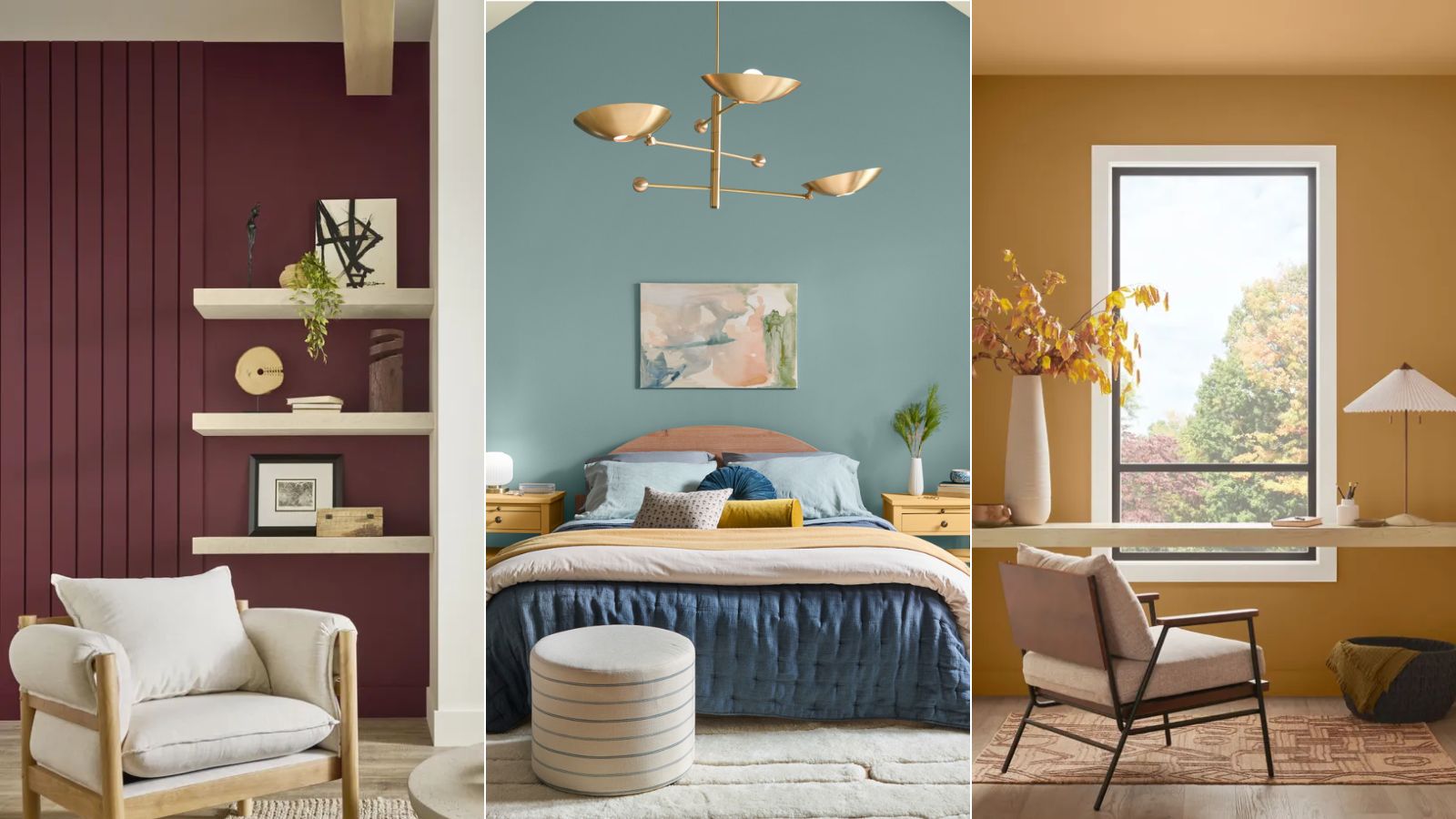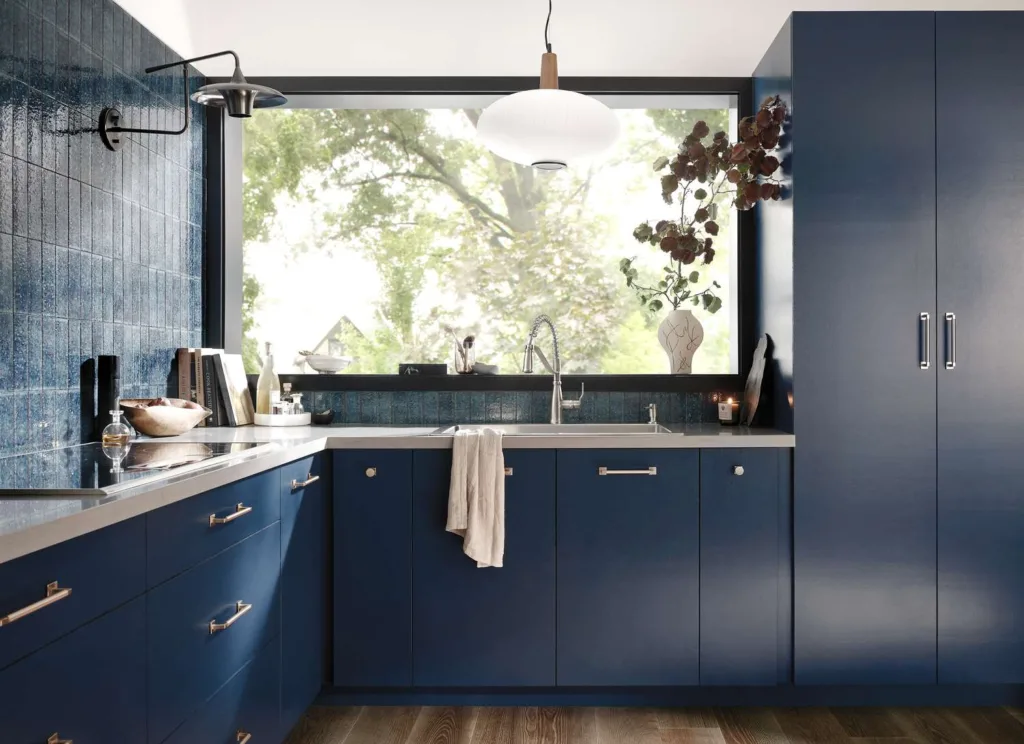News
Color Trends and Modern Home Appliance Designs in 2025
As we move into 2025, home appliances are no longer just functional items but integral parts of home décor that reflect our personal style. The fusion of innovative technology and aesthetic design is creating appliances that are as visually appealing as they are practical. From smart refrigerators to energy-efficient dishwashers, these modern devices are changing the way we view appliances, transforming them into sleek, stylish statements that elevate our living spaces.
In this article, we will dive into the color trends and design innovations shaping the world of home appliances in 2025. Whether you’re renovating your kitchen or updating your living room, understanding the design trends in appliance aesthetics can help you make informed decisions that blend functionality with style. Let’s explore what’s trending in modern appliance design and how you can incorporate these cutting-edge features into your home.
2025 Color Trends in Home Appliances: Embracing Bold, Sophisticated, and Sustainable Hues

A Shift Towards Neutral and Earthy Tones
In recent years, neutral tones have dominated the world of home appliances. These colors not only blend seamlessly into a variety of home décor styles but also evoke a sense of calm and simplicity. For 2025, however, we’re seeing a shift towards a more earthy palette, with rich shades of terracotta, sage green, and charcoal gray taking center stage. These colors bring warmth and sophistication to modern appliances, making them ideal for contemporary kitchens and living spaces.
While white, black, and stainless steel will always be staples, these new earthy tones offer a refreshing alternative that creates a more inviting and natural feel. These hues complement minimalist design principles and sustainable living, which are key themes in 2025’s home appliance trends.
Why Neutral and Earthy Tones Are Gaining Popularity
Timeless elegance: Earthy colors are timeless and versatile, seamlessly blending with various design styles, from mid-century modern to boho chic.
Sustainability: Neutral and natural tones are often associated with sustainability, and these colors align with eco-friendly appliance trends.
Soothing atmosphere: These colors evoke calmness, making them ideal for high-traffic areas like kitchens, where cooking and gathering take place.
Bold Accents and Pops of Color for 2025
While neutrals are making a comeback, 2025 will also see bold accent colors taking center stage in appliance designs. Vibrant shades like mustard yellow, deep navy, and emerald green will be featured in everything from coffee makers to refrigerators. These bold colors make a statement and add personality to otherwise neutral spaces.
The use of vibrant accents in home appliances is ideal for people who want their devices to stand out and be a part of their home’s overall design. For instance, an emerald green oven or mustard yellow kettle can serve as a focal point in a kitchen or living room, adding energy and vibrancy to the space.
The Role of Bold Accents in Appliance Design
Personalization: Bold colors allow homeowners to express their personality through their appliances, creating a more customized home environment.
Modern appeal: Bright accents create a dynamic and contemporary feel that contrasts with traditional, neutral tones.
Attention-grabbing: These colors are perfect for creating standout features in areas that may otherwise seem bland or lacking in visual interest.
Design Innovations: The Intersection of Functionality and Aesthetics

Sleek, Minimalist Designs: The Future of Appliance Aesthetics
Minimalist design is a strong influence in the world of modern appliances for 2025. Sleek lines, hidden controls, and flush-mounted features are now common in many high-end appliances. This design philosophy focuses on reducing visual clutter and creating appliances that blend effortlessly into the background, allowing the overall room aesthetic to shine.
In the kitchen, for example, appliances like dishwashers and microwave ovens are being designed with invisible panels that match the color of surrounding cabinetry, creating a uniform and clean appearance. The hidden control panels on refrigerators and ovens are also becoming more popular, giving these appliances a more streamlined and modern look.
Why Minimalist Design Is Popular in 2025
Space-saving: Sleek, compact designs fit well in smaller kitchens or apartments, making them perfect for urban dwellings.
Elegance: Minimalist aesthetics convey sophistication and elegance, making appliances feel like a natural part of the overall décor.
Easy maintenance: Fewer visible seams and controls make appliances easier to clean and maintain.
Smart Features in Appliance Design: Bringing Technology to the Forefront
As smart technology continues to evolve, more appliances are integrating advanced digital features that make daily tasks easier and more efficient. From voice-controlled refrigerators to self-cleaning ovens, the future of appliance design is all about automation and intelligence.
For instance, in 2025, you might see kitchen gadgets that not only prepare meals but also suggest recipes based on the ingredients you have in your smart refrigerator. Similarly, smart washing machines that can be controlled remotely via smartphone apps allow you to start a load of laundry, monitor progress, or receive alerts when a cycle is complete.
Key Benefits of Smart Appliance Design
Automation: Smart appliances automate many everyday tasks, saving you time and effort in your routine.
Connectivity: Integrated apps and voice-control systems enhance the functionality and convenience of appliances.
Efficiency: Smart features allow appliances to work at optimal efficiency, adjusting settings for maximum energy savings and water conservation.
Sustainability in Appliance Design: Eco-Friendly Innovations for 2025
Energy-Efficient Appliances: Saving Resources for the Future
With sustainability becoming an essential consideration for both manufacturers and consumers, 2025 will see a strong emphasis on energy efficiency in appliance design. Modern home appliances are now built to meet stringent energy standards, reducing electricity consumption and helping consumers save on utility bills. From energy-efficient washing machines to low-energy refrigerators, these devices are designed to perform effectively while using minimal resources.
For example, many dishwashers and washing machines now feature eco-friendly modes that reduce energy use by optimizing water temperature and cycle length. The rise of smart thermostats also plays a significant role in home heating and cooling, adjusting to your schedule and ensuring that no energy is wasted.
Why Sustainability Is a Key Focus for 2025
Cost savings: Energy-efficient appliances help homeowners save money by reducing utility bills.
Environmental impact: By using less energy and water, these devices contribute to lower carbon footprints and reduced environmental degradation.
Long-term durability: Sustainable appliances are often designed to be more durable and longer-lasting, offering better value over time.
Eco-Friendly Materials and Packaging
As consumers become more conscious of plastic waste and environmental impact, appliance manufacturers are turning to eco-friendly materials for both the products and their packaging. In 2025, you can expect more appliances made from recyclable materials, biodegradable plastics, and sustainable composites. This trend helps reduce the environmental footprint of both the manufacturing and disposal processes.
Innovative Recycling Systems in Appliances
Some appliances are now incorporating recycling features into their design. For instance, smart dishwashers may have systems to filter and reuse water, while smart washing machines recycle water used during wash cycles for the next load. This not only conserves water but also reduces the need for frequent water changes, contributing to both water and energy savings.
Combining Color and Design: Achieving Harmony in Modern Home Appliances
Choosing Colors that Complement Your Home Décor
As the color trends for 2025 evolve, it’s important to understand how to incorporate these tones into your home appliances for a cohesive design. Whether you prefer earthy neutrals, bold accents, or metallic finishes, choosing appliances that blend seamlessly with your overall décor can elevate the style of your home. Bold accent colors can be a statement piece in the kitchen or living room, while earth tones work well in creating a more calming and grounded atmosphere.
For example, a black matte refrigerator with sleek lines can create a sophisticated, minimalist look in a modern kitchen, while a vibrant mustard yellow toaster can add a pop of personality to a neutral countertop.
Creating a Harmonious Interior with Appliances
When selecting appliances, consider the overall design theme of your home. Modern open-plan living spaces benefit from appliances that offer both functionality and style. Integrated appliances, such as built-in dishwashers and fridges, can help create a seamless design where appliances blend into the cabinetry, allowing for a cohesive and clutter-free environment.
Conclusion: Embrace the Future of Home Appliances
In 2025, the future of home appliances is all about sustainability, smart technology, and aesthetic design. Whether you’re looking for energy-efficient devices, vibrant appliance colors, or sleek, minimalist designs, the trends are clear—appliances are no longer just tools; they are integral parts of a stylish, sustainable home. By understanding the latest trends in color and design, you can create a modern, functional space that is both beautiful and environmentally friendly.
Future-Proofing Your Home with Smart and Sustainable Appliances
As we look ahead to 2025, home appliances continue to evolve with an increasing emphasis on smart technology and sustainability. These innovations not only enhance the functionality of everyday devices but also reflect the growing consumer demand for eco-friendly solutions that reduce energy consumption, improve efficiency, and contribute to a cleaner planet. In this section, we’ll delve deeper into how smart appliances and sustainable designs are shaping the future of modern homes, and how these trends are not just aesthetically pleasing but also incredibly practical.
The Rise of Smart Appliances: Enhancing Home Efficiency
Seamless Integration with Smart Home Systems
In 2025, one of the biggest trends in home appliances is the seamless integration of devices into smart home ecosystems. Smart home technologies such as Google Home, Amazon Alexa, and Apple HomeKit are providing homeowners with unprecedented control over their appliances. With just a few taps on your smartphone or a voice command, you can control a wide variety of appliances, from adjusting your smart thermostat to turning off your robot vacuum cleaner.
This level of integration goes beyond just convenience. It allows for more efficient management of energy usage, helping to optimize electricity and water consumption. For instance, a smart washing machine can be programmed to run when electricity rates are lower, or it can be remotely controlled to prevent waste when you forget to switch it off.
Benefits of Smart Home Integration
Efficiency and convenience: Automate routines, set schedules, and control multiple devices from one central hub.
Energy optimization: Devices automatically adjust based on real-time conditions, ensuring minimal energy consumption.
Remote control: Manage your appliances from anywhere using a smartphone app, making it easy to monitor and adjust your home’s systems.
Artificial Intelligence and Predictive Functionality
A key aspect of smart home appliances in 2025 is the use of artificial intelligence (AI) to predict your needs and adjust appliance behavior accordingly. Imagine a smart refrigerator that tracks your grocery inventory, suggests recipes, and alerts you when certain items are running low or close to expiration. AI-powered washing machines can adjust washing cycles based on fabric type and soil level, reducing water and energy use without compromising performance.
How AI Improves Appliance Efficiency
Learning from habits: AI-enabled devices learn from your preferences and adjust settings for maximum efficiency.
Automation: Appliances automatically adjust their operations to save energy and reduce waste, even without your direct input.
Personalized experiences: AI tailors appliance functions to your specific needs, improving overall convenience and reducing resource consumption.
Sustainable Appliance Design: Reducing Environmental Impact
Eco-Friendly Materials and Manufacturing
In addition to energy and water-saving features, many 2025 appliances are designed with eco-friendly materials. The shift towards sustainable manufacturing processes has resulted in appliances made from recyclable materials, non-toxic finishes, and energy-efficient components. For example, energy-efficient dishwashers now come with parts made from recycled plastics and metals, reducing their environmental impact during both production and disposal.
Manufacturers are also incorporating low-impact production methods that reduce waste and carbon emissions. The trend towards sustainable design reflects a growing commitment within the industry to create long-lasting appliances that have minimal negative effects on the environment.
Key Features of Sustainable Appliances:
Recyclable materials: Appliances are now built with parts that can be reused or recycled at the end of their lifecycle.
Environmentally friendly manufacturing: Appliances are produced with minimal environmental impact, reducing carbon emissions and waste.
Durability and longevity: High-quality materials and superior engineering mean appliances last longer, reducing the frequency of replacements and landfill waste.
Water and Energy Conservation in 2025
As the demand for eco-friendly appliances grows, more manufacturers are prioritizing water and energy conservation. Energy Star ratings are becoming a crucial factor in appliance purchases, with many models designed to use far less water and power than traditional alternatives. Smart thermostats, for example, automatically adjust heating and cooling based on your schedule and the room’s temperature, leading to significant energy savings.
Similarly, low-flow faucets and water-efficient showerheads are becoming standard features in many homes, as they drastically reduce water consumption without compromising comfort. Washing machines and dishwashers are also built to use less water while still providing excellent cleaning results, making them an excellent choice for households seeking to reduce their water usage.
How Water and Energy Conservation Benefits the Environment:
Reduced consumption: Water-saving appliances help conserve a vital natural resource, while energy-efficient models reduce the demand for fossil fuels.
Lower carbon emissions: Efficient appliances contribute to reduced greenhouse gas emissions by using less electricity and water.
Cost savings: Homeowners save money on both water and energy bills, making these appliances a win-win for the environment and the wallet.
Personalized Appliance Design: Tailored to Your Lifestyle
Customizable Features for Unique Needs
As consumer preferences evolve, manufacturers are increasingly offering customizable appliances that allow homeowners to adjust their devices to suit their unique needs. For instance, modular refrigerators in 2025 can be configured with separate sections that cater to specific food types, with some models even allowing you to adjust temperature settings for different zones in the fridge. This level of personalization not only maximizes energy efficiency but also reduces food waste by keeping your items fresher for longer.
Similarly, modular washing machines can be adjusted for different load sizes and fabric types, and some models even allow for quick wash cycles that save both water and energy. Customizable appliances allow users to fine-tune settings based on their lifestyle, helping reduce unnecessary energy consumption and prolonging the lifespan of the appliance.
Benefits of Customizable Appliances:
Tailored efficiency: Appliances that adapt to your lifestyle use only the necessary energy and water, ensuring minimal waste.
Convenience: Customization features provide added convenience and a more personalized experience.
Increased longevity: Appliances that are tailored to fit your needs are less likely to experience wear and tear from excessive use.
Smart Kitchens: The Integration of Appliances for Seamless Operation
2025 will see the rise of smart kitchens, where all appliances are interconnected through a central smart system. A smart kitchen allows for seamless communication between devices, from the smart refrigerator that suggests recipes based on ingredients you have, to the oven that preheats automatically when the refrigerator identifies that you’re ready to cook.
These intelligent systems are designed to optimize energy and water consumption. For example, the oven might adjust its heat levels to cook a dish more efficiently, while the dishwasher could detect the load and adjust water levels accordingly, saving water and detergent. As the demand for intelligent, energy-efficient homes increases, kitchen appliances are becoming more interconnected, contributing to a smart, sustainable home ecosystem.
Advantages of Smart Kitchen Integration:
Efficiency: Smart appliances work together to optimize energy and water use.
Automation: Many functions can be automated, saving time and effort while improving efficiency.
Personalized cooking experiences: Smart devices can recommend recipes, cooking methods, and adjust appliance settings based on your preferences.
Conclusion: The Future of Appliance Design – A Sustainable, Smart, and Stylish Solution
The home appliance industry in 2025 is rapidly evolving to meet the demands of a more sustainable, efficient, and connected world. Whether it’s through smart technology, eco-friendly materials, or energy-efficient innovations, the appliances of tomorrow are designed to improve our daily lives while reducing our environmental footprint. As we move toward a more sustainable lifestyle, choosing modern home appliances that align with these values will not only help protect the planet but also improve our living standards.
From energy-efficient dishwashers and smart refrigerators to water-saving washing machines and customizable kitchen appliances, the trends of 2025 are about efficiency, personalization, and sustainability. By investing in these cutting-edge technologies, homeowners can enjoy a stylish, functional, and eco-friendly living space.
The Role of Smart Appliances in Creating a Connected Home
In addition to the design and aesthetic innovations in home appliances, smart technology is becoming an integral part of how we interact with devices in our homes. The Internet of Things (IoT) is transforming everyday appliances, allowing them to connect and communicate with each other, creating a seamless and intelligent home ecosystem. By integrating smart technologies, appliances no longer just perform their intended tasks; they become interactive, adaptable, and highly efficient.
Interconnected Devices: Creating a Cohesive Home Environment
One of the most significant advantages of smart appliances in 2025 is their ability to communicate with one another. Smart refrigerators can sync with your smartphones, allowing you to track inventory, suggest recipes, and even order groceries online. These devices can alert you when items are running low or nearing their expiration dates. Meanwhile, your smart oven can automatically adjust its cooking time and temperature based on the recipe you’ve selected, while your dishwasher can adjust its settings to optimize water usage for the load inside.
Voice-Controlled Appliances: Hands-Free Convenience
In 2025, voice-controlled appliances are becoming an essential part of the smart home experience. Using voice assistants like Amazon Alexa, Google Assistant, or Apple Siri, homeowners can control a wide variety of appliances simply by issuing commands. Want to start the dishwasher while cooking dinner? Just say the word. Need to preheat the oven before you arrive home from work? It’s as simple as asking.
The convenience of voice-controlled appliances extends beyond just kitchen devices. Smart thermostats allow you to adjust the temperature in your home with ease, while smart lighting systems can be controlled with your voice, adjusting the ambiance to fit your needs. Whether it’s dim lighting for movie night or bright lights for a productive morning, voice-controlled systems give you full control over your environment, making your daily routines more efficient and customizable.
Integration with Home Automation Systems
As smart home ecosystems grow, the potential for appliance integration expands. Home automation systems can control multiple devices from a central hub, making it easy to manage everything from lighting and security systems to climate control and entertainment systems. In 2025, we are seeing a rise in appliance integration where your appliances not only respond to manual input but can also adjust themselves based on environmental factors. For example, a smart refrigerator can reduce energy consumption by automatically entering an energy-saving mode when it detects that the house is empty.
This smart integration also leads to a more sustainable way of living. By connecting various devices to a central hub, homeowners can track their energy consumption, water usage, and appliance performance more efficiently. Over time, these devices can adapt to your specific habits, optimizing both performance and resource use, which ultimately reduces waste.
Embracing the Future: Why You Should Consider Smart and Sustainable Appliances
The future of home appliance design in 2025 is about combining efficiency, style, and sustainability. From smart refrigerators that manage food inventory to water-saving washing machines that use the least water possible, these innovations are not just about making life easier—they’re about making it better. As environmental concerns continue to grow, the shift towards more energy-efficient and eco-friendly appliances is essential for reducing our collective impact on the planet.
Smart appliances offer a new level of convenience, allowing homeowners to have more control over their energy consumption and water usage. By investing in cutting-edge appliances that offer eco-friendly features, you can not only enhance your home’s aesthetic appeal but also contribute to a greener, more sustainable world.
As we move further into 2025, embracing smart technology and sustainable design in our appliances will become the standard. These devices don’t just help with everyday tasks—they improve quality of life, save resources, and provide long-term benefits that extend beyond just personal use. By integrating these appliances into your home, you’re not only staying ahead of design trends but also investing in the future of the planet.
Now is the perfect time to update your home with the latest smart appliances and embrace a sustainable, connected future. Start with energy-efficient devices, choose eco-friendly materials, and create an interconnected environment that works for you and the planet. Make your home smarter, greener, and more stylish today!

